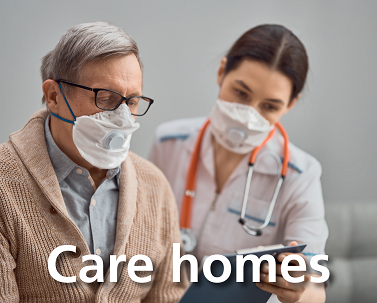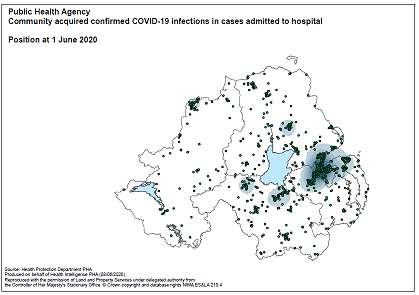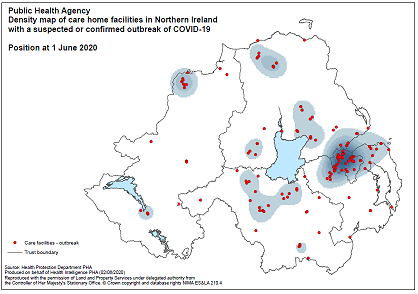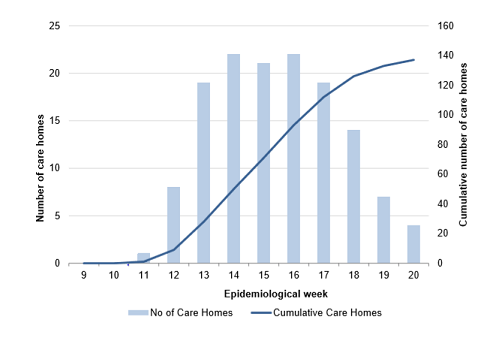By Dr Claire Neill, Specialty Registrar in Public Health, Public Health Agency. To view our complete series of COVID-19 blogs, click here.

Those living in care home settings, including nursing and residential homes, disability and mental health, have been described by the World Health Organisation as being vulnerable to COVID-19. As the infection has spread and affected our communities, it has also impacted our care homes. Protecting care home residents and supporting the dedicated staff that care for them, is a key priority for us in the Public Health Agency (PHA).
Our care homes are currently at the forefront of the COVID-19 outbreak, and we appreciate the additional challenges this poses to maintaining ongoing care and assistance to residents. Residents are at increased risk of adverse outcomes, with higher prevalence of underlying medical conditions, and older age. They are also at higher risk of infection due to living in close proximity to others, and having frequent contact with carers. This increased risk in care homes is not unique to Northern Ireland, with care homes across many countries seriously impacted by COVID-19. Unfortunately, COVID-19 associated deaths have occurred in our homes. Every death is one too many, and a tragedy to families and loved ones. Preventing the spread of infection within these facilities is a key priority, to prevent illness and further devastation.
Research shows that a one size approach does not fit all, which is not surprising given the different types of care homes we have. The Health Protection team in the PHA have an established process to risk assess and help manage COVID-19 in care homes across Northern Ireland. The information gathered is also used to monitor trends in outbreaks in this setting. Having this information allows us to understand the spread of infection in communities and in care homes, described in more detail below.
COVID-19 infection in our communities
In Northern Ireland, the number of people diagnosed with COVID-19 infection each day is declining. As of 8 June 2020 a total of 4,796 individuals have had a laboratory confirmed COVID-19 infection in Northern Ireland. The following figure shows the distribution of those who acquired infection in the community and were admitted to hospital, by 1 June, 2020. The highest proportion of total cases is from the Belfast area.

Figure 1: Community acquired COVID-19 in individuals admitted to hospital in Northern Ireland
COVID-19 infections in care homes
During the current pandemic, the PHA has supported more than 100 care homes with a suspected or confirmed outbreak of COVID-19. The pattern of affected care homes, also by 1 June 2020, is shown in the figure below. As we have seen with community cases of COVID-19, the highest proportion of care home outbreaks is also in the Belfast area.

Figure 2: Outbreaks of suspected or confirmed COVID-19 in care homes in Northern Ireland
Applying the emerging evidence base and knowledge of spread of COVID-19 in communities and in care homes has informed our response to this ongoing situation. We continue to work with each individual care home with suspected or confirmed COVID-19 by providing advice, and supporting them to stop the spread of infection. By collecting and monitoring COVID-19 outbreak notifications received by the PHA, we can also monitor spread of disease and the response to public health measures. This helps us to work with the home and other partner organisations (including RQIA, Trusts, and the Department of Health) to provide additional support.
The PHA has been involved in developing local evidence on testing for COVID-19 in care homes, supporting the benefits of testing asymptomatic residents and staff, which has informed and supported policy changes in Northern Ireland. We are continuing to work with Trusts to ensure all care home staff and residents are offered testing by the end of June 2020.
The impact of COVID-19 and time spent in lockdown has been challenging, particularly to the more vulnerable in society. It is important to remember that by protecting everyone in the community and slowing the transmission of disease we will also be protecting those in care homes. This happens because lowering the burden of disease in the community will reduce the chance that COVID-19 will be introduced into the home. As we are seeing the reduction of COVID-19 in communities, we are also seeing reduced outbreaks in care homes (Figure 3).

Figure 3: Number of care homes each week and cumulative total of care homes with a confirmed or suspected COVID-19 outbreak in Northern Ireland, 2020
While we anticipate that COVID-19 will continue to present a challenge for us all, but particularly the most vulnerable in the community and in care homes, the PHA will continue to monitor the situation closely and respond appropriately to reduce spread.
With thanks for data provided by Fraser Menzies and Maria O’Hagan.
To view our complete series of COVID-19 blogs, click here.
